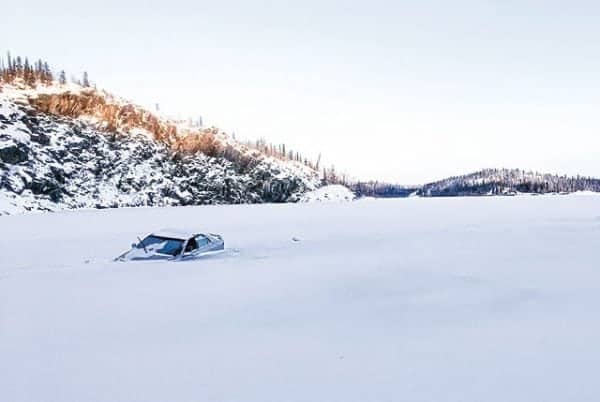"Oops. There goes another one!" Perhaps we should broadcast that jingle, all over town, whenever someone breaks through the ice in or around town. It doesn’t matter if they are walking, riding a snowmobile or driving a vehicle. If they go through the ice that jingle plays. Loud and clear. Maybe that would warn others to be careful.
This winter, it seems that a lot of people are going through the ice. Some of the accidents are even sort of comical, as long as no one gets hurt.
However, the more of them that there are, the more likely it is that someone will get hurt or even perish. So, before that happens, it might be a good time for individuals and the government, to take this problem a whole lot more seriously, then they seem to. Hence the jingle.
Every year, more and more people, are out and about, travelling over the lakes as soon as they freeze over. Many of the people are visitors or relatively new to the north and they don’t seem to have the experience, bush smarts or access to local information to appreciate the risks they are taking.
They see that people are starting to venture out on the ice and then for some reason, they think that because the ice is safe in one place, that it is safe everywhere, and that just isn’t true.
You have to remember lakes are dynamic things. You could even consider them living things. If you want to understand ice safety, you have to learn about the lakes.
Consider Great Slave Lake for a moment. It has several rivers flowing into it and one really big river flowing out of it. They all freeze over in winter and people travel on them, but water is still flowing into the lake under the ice and it is flowing out, under the ice.
These means that even in winter there are currents in the lake and moving water can eat away at the ice and even make it disappear entirely.

It all depends on the geography and the topography of the lake bottom. A reef can cause the water to flow up and erode the ice. Currents around islands can cause thin ice. Narrows can cause the water to move faster and thin the ice. In some cases, narrows combined with a shallow reef can cause open water to occur all winter long.
If you were to take a series of maps of the local lakes and plot all the locations where people have gone through the ice this year and then plot all the locations where people have gone through the ice over the last 40 years, you would discover that people just keep breaking through the ice at pretty much the same spots, year after year.
Using past accidents and local knowledge someone could draw up a set of maps showing the dangerous or risky spots. Someone could even go out and mark all the spots but that would be very time consuming.
This might cut down on the accidents but let’s face it, some people don’t read maps or heed warning signs.
Also, if you stick up a sign that says Thin Ice, sure as heck, someone is going to drive right up to it, to see what it says and that wouldn’t be good. Big signs with maps of the dangerous areas at the access points to the lakes, might help. If enough people stopped to look at them.
Educating people on winter travel would be a good idea and I think every rental vehicle should have a little pamphlet to warn people about the hazards of winter driving. Plus, a whole bunch more research should be done.
Winter roads on the local lakes are great but ironically, they may make the dangerous spots even more dangerous. This is because the roads help creates currents as vehicles use them.
Just put an ice hole near a road and watch the water giggle every time a vehicle goes by. The weight of the vehicle pushes the ice down displacing water and when it passes the water return and the ice rises again. That and the vibrations created have to have an affect on the ice and lake.
We really should do something, so we hear fewer "Oops, there goes another one."
Not only is it expensive pulling all those vehicles, snowmobiles and people out of the lake, it pollutes the water and sooner or later someone is going to get hurt.